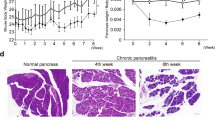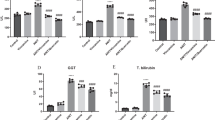Abstract
Background: A major mechanism underlying warm ischemia/reperfusion (I/R) injury during liver transplantation is the activation of the caspase chain, which leads to apoptosis. Recently, it was demonstrated that the release of cathepsin B, a cysteine protease, from the cytosol in liver injury induces mitochondrial release of cytochrome c and the activation of caspase-3 and -9, thereby leading to apoptosis. The aim of this study was to ascertain if cathepsin B inactivation attenuates the apoptotic injury due to I/R in mouse liver.
Methods: A model of segmental (70%) hepatic ischemia was used. Eighteen mice were anesthetized and randomly divided into three groups: (1) Control group: sham operation (laparotomy); (2) Ischemic group: midline laparotomy followed by occlusion of all structures in the portal triad to the left and median lobes for 60 min (ischemic period); (3) Study group: like group 2, but with intraperitoneal administration of a pharmacological inhibitor of cathepsin B (4 mg/100 g) 30 min before induction of ischemia. Serum liver enzyme levels were measured by biochemical analysis, and intrahepatic caspase-3 activity was measured by fluorometric assay; apoptotic cells were identified by morphological criteria, the terminal deoxynucleotidyl transferase-mediated dUTP nick-end labeling (TUNEL) fluorometric assay, and immunohistochemistry for caspase-3. Results: Showed that at 6 h of reperfusion, there was a statistically significant reduction in liver enzyme levels in the animals pretreated with cathepsin B inhibitor (p < 0.05). On fluorometric assay, caspase-3 activity was significantly decreased in group 3 compared to group 2 (p < 0.0001). The reduction in postischemic apoptotic hepatic injury in the cathepsin B inhibitor -treated group was confirmed morphologically, by the significantly fewer apoptotic hepatocyte cells detected (p < 0.05); immunohistochemically, by the significantly weaker activation of caspase-3 compared to the ischemic group (p < 0.05); and by the TUNEL assay (p < 0.05). Conclusion: The administration of cathepsin B inhibitor before induction of ischemia can attenuate postischemic hepatocyte apoptosis and thereby minimize liver damage. Apoptotic hepatic injury seems to be mediated through caspase-3 activity. These findings have important implications for the potential use of cathepsin B inhibitors in I/R injury during liver transplantation.
Similar content being viewed by others
References
Jaeschke H, Lemasters JJ. Apoptosis versus oncotic necrosis in hepatic ischemia/reperfusion injury. Gastroenterology 2003; 125: 1246–1257.
Rudiger HA, Graf R, Clavien PA. Liver ischemia: Apoptosis as a central mechanism of injury. J Invest Surg 2003; 16: 149–159.
Roberts LR, Kurosawa H, Bronk SF, et al. Cathepsin B contributes to bile salt-induced apoptosis of rat hepatocytes. Gastroenterology 1997; 113: 1714–1726.
Jones B, Roberts PJ, Faubion WA, Kominami E, Gores GJ. Cystatin A expression reduces bile salt-induced apoptosis in a rat hepatoma cell line. Am J Physiol 1998; 275: G723–G730.
Guicciardi ME, Deussing J, Miyoshi H, et al. Cathepsin B contributes to TNF-α-mediated hepatocyte apoptosis by promoting mitochondrial release of cytochrome c. J Clin Invest 2000; 106: 1127–1137.
Guicciardi ME, Miyoshi H, Bronk SF, Gores GJ. Cathepsin B knockout mice are resistant to tumor necrosis factor-α-mediated hepatocyte apoptosis and liver injury. Am J Pathol 2001; 159: 2045–2054.
Canbay A, Guicciardi ME, Higuchi H, et al. Cathepsin B inactivation attenuates hepatic injury and fibrosis during cholestasis. J Clin Invest 2003; 112: 152–159.
Selzner M, Rudiger HA, Selzner N, Thomas DW, Sindram D, Calvien PA. Bcl-2 overexpression in transgenic mice protects against ischemia & reperfusion injury of the liver. J Hepatol 2002; 36: 218–225.
Roberts LR, Adjei PN, Gores GJ. Cathepsin as effector proteases in hepatocyte apoptosis. Cell Biochem Biophys 1999; 30: 71–88.
Foghsgaard L, Wissing D, Mauch D, et al. Cathepsin B acts as a dominant execution protease in tumor cell apoptosis induced by tumor necrosis factor. J Cell Biol 2001; 153: 999–1010.
Werneburg NW, Guicciardi ME, Bronk SF, Gores GJ. Tumor necrosis factor-alpha-associated lysosomal permeabilization is cathepsin B dependent. Am J Physiol Gastrointest Liver Physiol 2002; 283: G947–G956.
Werneburg NW, Guicciardi ME, Yin XM, Gores GJ. TNF-alpha-mediated lysosomal permeabilization is FAN and caspase 8/Bid dependent. Am J Physiol Gastrointes Liver Physiol 2004; 287: G436–G443.
Baskin-Bey ES, Canbay A, Bronk SF, et al. Cathepsin b inactivation attenuates hepatocyte apoptosis and liver damage in steatotic livers after cold ischemia/warm reperfusion injury. Am J Physiol Gastrointest Liver Physiol 2005; 283: G947–G956.
Author information
Authors and Affiliations
Corresponding author
Rights and permissions
About this article
Cite this article
Ben-Ari, Z., Mor, E., Azarov, D. et al. Cathepsin B inactivation attenuates the apoptotic injury induced by ischemia/reperfusion of mouse liver. Apoptosis 10, 1261–1269 (2005). https://doi.org/10.1007/s10495-005-2358-1
Published:
Issue Date:
DOI: https://doi.org/10.1007/s10495-005-2358-1




